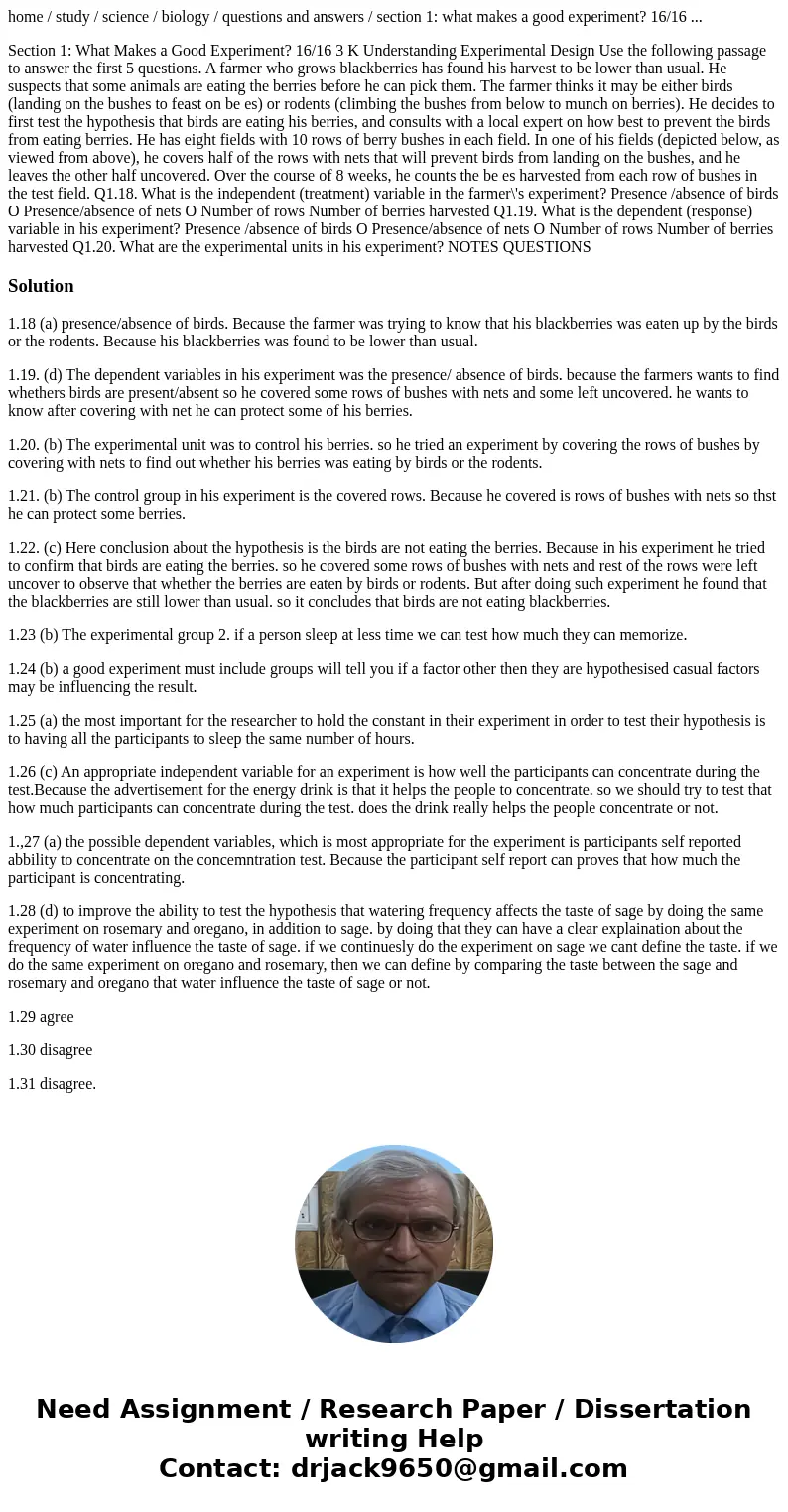home study science biology questions and answers sectio
home / study / science / biology / questions and answers / section 1: what makes a good experiment? 16/16 ...
Section 1: What Makes a Good Experiment? 16/16 3 K Understanding Experimental Design Use the following passage to answer the first 5 questions. A farmer who grows blackberries has found his harvest to be lower than usual. He suspects that some animals are eating the berries before he can pick them. The farmer thinks it may be either birds (landing on the bushes to feast on be es) or rodents (climbing the bushes from below to munch on berries). He decides to first test the hypothesis that birds are eating his berries, and consults with a local expert on how best to prevent the birds from eating berries. He has eight fields with 10 rows of berry bushes in each field. In one of his fields (depicted below, as viewed from above), he covers half of the rows with nets that will prevent birds from landing on the bushes, and he leaves the other half uncovered. Over the course of 8 weeks, he counts the be es harvested from each row of bushes in the test field. Q1.18. What is the independent (treatment) variable in the farmer\'s experiment? Presence /absence of birds O Presence/absence of nets O Number of rows Number of berries harvested Q1.19. What is the dependent (response) variable in his experiment? Presence /absence of birds O Presence/absence of nets O Number of rows Number of berries harvested Q1.20. What are the experimental units in his experiment? NOTES QUESTIONSSolution
1.18 (a) presence/absence of birds. Because the farmer was trying to know that his blackberries was eaten up by the birds or the rodents. Because his blackberries was found to be lower than usual.
1.19. (d) The dependent variables in his experiment was the presence/ absence of birds. because the farmers wants to find whethers birds are present/absent so he covered some rows of bushes with nets and some left uncovered. he wants to know after covering with net he can protect some of his berries.
1.20. (b) The experimental unit was to control his berries. so he tried an experiment by covering the rows of bushes by covering with nets to find out whether his berries was eating by birds or the rodents.
1.21. (b) The control group in his experiment is the covered rows. Because he covered is rows of bushes with nets so thst he can protect some berries.
1.22. (c) Here conclusion about the hypothesis is the birds are not eating the berries. Because in his experiment he tried to confirm that birds are eating the berries. so he covered some rows of bushes with nets and rest of the rows were left uncover to observe that whether the berries are eaten by birds or rodents. But after doing such experiment he found that the blackberries are still lower than usual. so it concludes that birds are not eating blackberries.
1.23 (b) The experimental group 2. if a person sleep at less time we can test how much they can memorize.
1.24 (b) a good experiment must include groups will tell you if a factor other then they are hypothesised casual factors may be influencing the result.
1.25 (a) the most important for the researcher to hold the constant in their experiment in order to test their hypothesis is to having all the participants to sleep the same number of hours.
1.26 (c) An appropriate independent variable for an experiment is how well the participants can concentrate during the test.Because the advertisement for the energy drink is that it helps the people to concentrate. so we should try to test that how much participants can concentrate during the test. does the drink really helps the people concentrate or not.
1.,27 (a) the possible dependent variables, which is most appropriate for the experiment is participants self reported abbility to concentrate on the concemntration test. Because the participant self report can proves that how much the participant is concentrating.
1.28 (d) to improve the ability to test the hypothesis that watering frequency affects the taste of sage by doing the same experiment on rosemary and oregano, in addition to sage. by doing that they can have a clear explaination about the frequency of water influence the taste of sage. if we continuesly do the experiment on sage we cant define the taste. if we do the same experiment on oregano and rosemary, then we can define by comparing the taste between the sage and rosemary and oregano that water influence the taste of sage or not.
1.29 agree
1.30 disagree
1.31 disagree.

 Homework Sourse
Homework Sourse